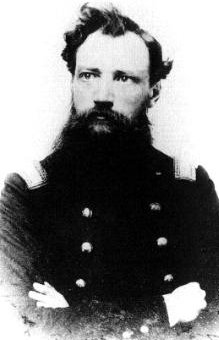Alexander Schimmelfennig facts for kids
Quick facts for kids
Alexander Schimmelfennig
|
|
|---|---|
 |
|
| Birth name | Alexander Ferdinand Schimmelpfennig von der Oye |
| Born | July 20, 1824 Bromberg, Prussia (now Bydgoszcz, Poland) |
| Died | September 5, 1865 (aged 41) Wernersville, Pennsylvania |
| Place of burial |
Charles Evans Cemetery,
Reading, Pennsylvania |
| Allegiance | |
| Service/ |
|
| Years of service | 1848–1849 1861–1865 |
| Rank | |
| Battles/wars | German revolutions of 1848–49
|
Alexander Schimmelfennig (July 20, 1824 – September 5, 1865) was a soldier from Prussia (a historical German state). He was also involved in political movements that wanted to change governments. After some revolutions in Germany in 1848–1849, he moved to the United States. There, he became a general in the Union Army during the American Civil War.
Contents
Early Life and European Adventures
Schimmelfennig was born in a city called Bromberg, which was part of Prussia. Today, this city is known as Bydgoszcz in Poland.
Joining the Prussian Army
He joined the Prussian army and served in two different infantry regiments. While stationed in Cologne, he started meeting people who wanted big political changes. He became active in the revolutions of 1848. These were a series of protests and uprisings across Europe where people wanted more freedom and different governments.
A Revolutionary's Journey
Schimmelfennig supported the "March Revolution" in Germany. He was part of a military group that led an uprising in a region called Palatine. He was hurt twice in a battle and had to escape. Because of his role in the revolution, he faced serious consequences and had to flee to Switzerland.
While in Switzerland, he met another German who had also left his home, Carl Schurz. They later traveled together to London, passing through Paris. In London, Schimmelfennig joined a German group that wanted more democratic government.
Moving to America
In 1854, Schimmelfennig moved to the United States. He found work with the United States Department of War, which manages the country's military. He stayed connected with other "Forty-Eighters". This was a name for people, often military officers, who had come to the U.S. after the failed revolutions of 1848 in Europe. Many of them later served in the Union Army. Schimmelfennig also wrote a book about the Crimean War.
Serving in the American Civil War
When the American Civil War began, Schimmelfennig wanted to help the Union.
Forming a Regiment
He first tried to create an all-German cavalry regiment with Carl Schurz. This didn't work out because Schurz was appointed to a diplomatic role. So, Schimmelfennig then tried to form an all-German infantry regiment in Philadelphia. He got sick, but his friends helped make sure the regiment was formed. This group of soldiers, made up of Germans from Philadelphia and Pittsburgh, became known as the 74th Pennsylvania Infantry.
Facing Prejudice
During the Civil War, there was some prejudice against immigrants, especially Germans, in the Union. This feeling was called "nativist sentiment." Many German troops were part of the XI Corps. At the Battle of Chancellorsville, this corps had to retreat after being attacked from the side. The German soldiers faced a lot of unfair criticism from the newspapers. Even their commander, Oliver Otis Howard, blamed them for his own mistakes. During this battle, Schimmelfennig led a brigade, which is a large group of soldiers.
The Battle of Gettysburg
At the famous Battle of Gettysburg, Schimmelfennig again commanded a brigade in the XI Corps. For a short time, he even took command of the entire 3rd Division. His brigade suffered many losses. Many soldiers got lost in the narrow streets of Gettysburg and were captured by the Confederate army.
Schimmelfennig's brigade tried its best to cover the retreat of the rest of the XI Corps. During the retreat through the town, Schimmelfennig hid in a small drainpipe and then stayed for several days in a shed to avoid being captured. There is a marker outside the house where he hid. After the battle, he rejoined his corps, much to the relief of his troops who thought he was dead. However, news writers used his hiding story to unfairly suggest that German soldiers were cowardly.
Later Service and Final Days
After Gettysburg, Schimmelfennig was moved to command a brigade in the Carolinas. He was in charge of the District of Charleston. He later had the honor of accepting the surrender of Charleston on February 18, 1865.
While serving in the swampy areas around Charleston, he caught a serious illness called tuberculosis. This disease eventually led to his death in Wernersville, Pennsylvania. He had gone there to a special health resort, hoping to find a cure.
Alexander Schimmelfennig is buried in Reading, Pennsylvania, at the Charles Evans Cemetery.
Images for kids


